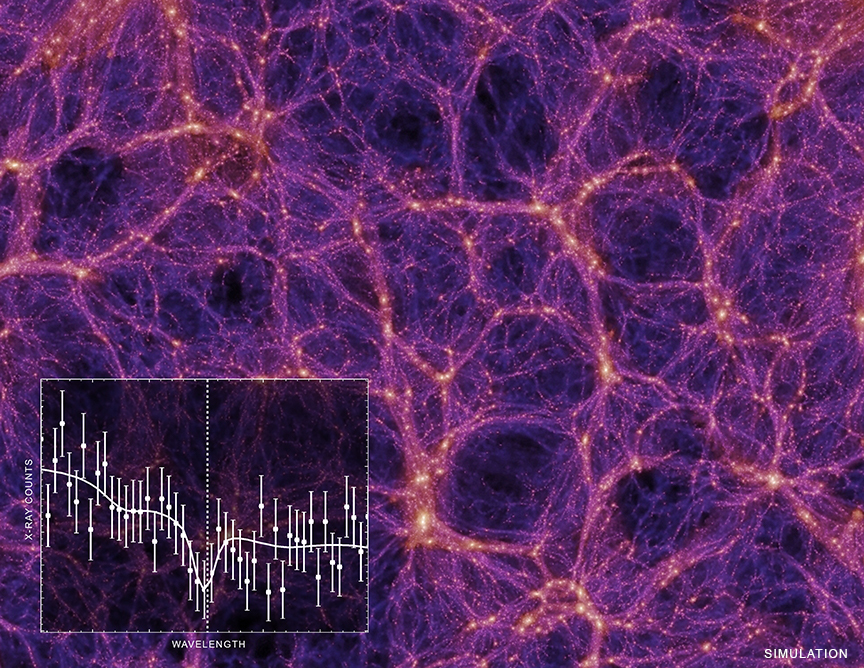
 Credit: Illustration: Springel et al. (2005); Spectrum: NASA/CXC/CfA/Kov‡cs et al.
Credit: Illustration: Springel et al. (2005); Spectrum: NASA/CXC/CfA/Kov‡cs et al.
Once Lost, Now Found?
Observations of the cosmic microwave background with satellites like COBE, WMAP and the Planck along with other lines of evidence have shown that, disturbingly, only about 5% of the Universe consists of stuff we understand, the normal atoms that make up everything in our material world, while 96% is composed of stuff we don't understand: Dark Matter and Dark Energy. The situation is actually even worse than that. Careful studies of the amount of normal matter in the Universe show that the amount of normal matter in the local Universe is only about 70% of the matter created during the Big Bang. Apparently we've misplaced 30% of the normal matter in the Universe. This stuff must be somewhere - but where? Astronomers have suggested that this material is locked up in the Warm Hot Intergalactic Medium - or WHIM - hot gas associated with the filaments of normal and dark matter that make up the cosmic web which forms the large-scale structure of the Universe. Such hot gas is difficult to detect, since it would be too hot to emit much optical radiation. This hot material could, however, absorb X-rays produced by a distant galaxy, if there's enough of this hot matter along our line of sight. Although any such absorption would be very weak, a group of astronomers have apparently found it. Astronomers carefully combined the X-ray radiation from an X-ray bright quasar called H1821+643. X-rays from the quasar pass through the intergalactic medium on its journey to earth, and, if it encounters the WHIM, hot, ionized atoms in the WHIM can absorb specific X-ray wavelengths. This will produce a slight dip in the quasar's X-ray spectrum. The image above shows, superimposed on a simulation of the filamentary structure of the WHIM, a section of the combined X-ray spectrum of H1821+643 seen by the Low Energy Transmission Grating spectrometer on the Chandra X-ray Observatory. This combined spectrum reveals a mild dip in the X-ray emission. This evidence suggests that, at least, some portion of the previously missing normal matter has now been found.
Published: March 4, 2018
<
HEA Dictionary ● Archive
● Search HEAPOW
● Other Languages
● HEAPOW on Facebook
● Download all Images
● Education ● HEAD
>

Each week the HEASARC
brings you new, exciting and beautiful images from X-ray and Gamma ray
astronomy. Check back each week and be sure to check out the HEAPOW archive!
Page Author: Dr. Michael F. Corcoran
Last modified Monday, 26-Feb-2024 17:36:52 EST


